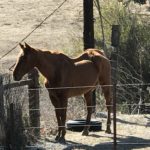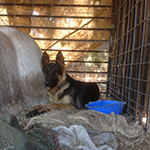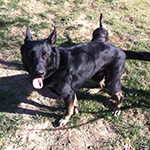Rodenticides Can Harm Wildlife
updated: Apr 18, 2015, 5:03 PM
By Animal Rescue Team, Inc.
Throughout California, the use of poison baits to control rodents has injured and killed hundreds or thousands of wild animals and pets. Predatory and scavenging birds and mammals like owls, hawks, raccoons, bobcats, mountain lions, foxes, skunks and coyotes that eat dead or dying rodents that have consumed these baits will also be poisoned. Pets will also eat dead or dying rodents and unprotected bait.
The best way to control rodents and protect wildlife and pets is to use non-chemical means of rodent control, such as exclusion and sanitation, when possible. If rodenticides are used, it is important to protect both pets and wildlife by following the label directions of any rodent baits you purchase, and only purchasing those that are legal for the pest you are trying to control. Because of documented hazards to wildlife, pets and children, the California Department of Pesticide Regulation has restricted public access to some of these materials in California. As of July 1, 2014, rodenticide products containing the active ingredients brodifacoum, bromadiolone, difethialone and difenacoum are only to be used by licensed applicators (professional exterminators). Products containing these four chemicals should not be on any store shelves where consumers could buy them. The U.S. Environmental Protection Agency additionally implemented a nationwide ban on consumer use of products that do not comply with safety requirements (www.epa.gov/pesticides/mice-and-rats/) in January 2015.
The California Department of Fish and Wildlife (CDFW) has also seen an increase in the number of strychnine-related wildlife losses in recent years. Strychnine is only legally used to control pocket gophers and must be placed underground in gopher burrows. Strychnine should not be used to control mice, rats or ground squirrels. Any above-ground use of strychnine may lead to unintentional poisoning of wildlife and pets, and may lead to enforcement action by CDFW, the appropriate County Agricultural Commissioner, or both.
Protect your wild neighbors, pets and children from accidental poisoning. Choose non-chemical pest control methods. If you must use pesticides, do so very carefully and follow all label directions.
How do rodent baits harm wildlife and pets?
It’s possible for wildlife and pets to consume the poison directly. However, it’s more common for some animals to receive a secondary exposure from anticoagulant rodenticides. A secondary exposure occurs when wildlife or pets consume dead or dying rodents that have eaten the rodent bait. Wildlife that can be affected by secondary poisoning include owls, hawks, eagles and mammals such as raccoons, foxes, bobcats, mountain lions and coyotes. Tertiary poisoning has also been documented, when two collared mountain lions died of anticoagulant ingestion after eating coyotes that had eaten poisoned rodents. Bromethalin is an acute poison and can kill wildlife that consume it. Several raccoons and skunks have died from eating bromethalin bait and it is critical that it either be used only indoors or in tamper-resistant bait stations.
How can I protect wildlife and pets, but still control rodent pests?
The most effective and safest ways to address rodent issues are through exclusion and sanitation. Seal off any rodent entrances to your home, remove debris from your yard and make pet food inaccessible to rodents. Traps can also be effective in removing rodent pests. If you use rodent bait, it is important to follow label directions carefully and immediately dispose of any rodent carcasses that result. Rodent baits with the active ingredients brodifacoum, bromadiolone, difethialone and difenacoum are very toxic and persistent and have been found widely in non-target wildlife. They are still legally available to professional exterminators, but to protect wildlife, please encourage those you employ to use other means of control.
Why are brodifacoum products so dangerous for wildlife and pets?
Brodifacoum, bromodialone, difenacoum and difethialone are toxic to rodents in a single feeding. However, the rodent will not die until several days after feeding and may continue to ingest more poison. The poison is then available to a predator or scavenger that eats the rodent. If the exposed rodent does not die, the poison can persist in its body for several months, and any animal that eats the rodent will ingest the poison.
How do these rodent baits work?
Brodifacoum, bromodialone, difenacoum and difethialone are second-generation anticoagulants. Warfarin, chlorophacinone and diphacinone are first-generation anticoagulant rodenticides. Both kinds of anticoagulant rodenticides work by preventing blood from clotting. Animals that ingest them die from internal hemorrhaging (bleeding) several days after ingesting the material. While the mechanism of all anticoagulants is similar, second-generation products (brodifacoum, bromadiolone, difenacoum and difethialone) are much more toxic and persistent, so they pose a much greater threat to non-target wildlife. Bromethalin and strychnine are neural toxicants. Cholecalciferol is an acute rodenticide that causes kidney failure.
How do you know rodent baits are poisoning wildlife?
Since 1994, CDFW’s Wildlife Investigation Laboratory has confirmed at least 400 cases of wildlife poisoning from anticoagulant rodent baits. Brodifacoum was the poison most frequently detected. Species harmed include coyote, gray fox, red fox, San Joaquin kit fox, fisher, raccoon, fox squirrel, bobcat, mountain lion, black bear, Hermann’s kangaroo rat, bald eagle, golden eagle, Canada goose, great-horned owl, barn owl, red-shouldered hawk, red-tailed hawk, Cooper’s hawk, turkey vulture and wild turkey.Since animals typically retreat to their dens, burrows or other hiding places in the final stages of anticoagulant poisoning, the number of non-target wildlife killed by these compounds is likely to be much greater than we know. Field monitoring of wild populations of bobcats, mountain lions, coyotes, San Joaquin kit foxes, fishers and raptors confirm widespread exposure to predatory and scavenging wildlife.
Can I control rodent pests without using poison baits?
Yes! The most effective rodent control program uses exclusion techniques (sealing the places where rodents enter your home) and sanitation (removing plants and objects that attract rodents and potential habitat such as ivy or wood piles); animal removal is used only when necessary. More information on controlling mice, rats and field rodents is provided on the University of California Integrated Pest Management website.
I found a dead raccoon (or other small wild animal) in my yard. What should I do?
First, do NOT touch it bare-handed. Wildlife can carry diseases and parasites, so always wear protective clothing – especially gloves – before handling dead or dying animals of any kind. If you’re in an urban or suburban area, you can call your city or county animal control office with detailed information about the animal’s appearance and condition. Even if they don’t have the staff to come retrieve it, they may like to know about it, as the one you found may not be the only one.
If I think my pet has been poisoned, what should I do?
If your pet is having seizures, is unconscious or losing consciousness, or is having difficulty breathing, phone ahead and take your pet to your local veterinarian or emergency veterinary clinic as soon as possible. If you know that your pet has had access to rodenticide, bring this information with you – especially the name of the product and active ingredient(s) – as it will help the veterinarian effectively treat your pet.
More Information
Rodent Control Information from UC Integrated Pest Management
USEPA Safer Rodenticide
General information, educational tools, projects, links to other sources: Raptors Are The Solution (RATS) (RATS is a project of the non-profit Earth Island Institute.)













